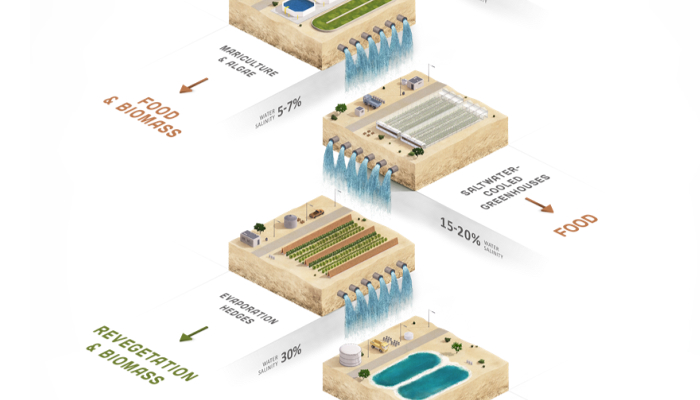While conventional approaches to production of goods often involve simple, mono-functional systems that aim to maximize one goal (for instance energy production or food output), the Sahara Forest Project involves creating a complex, interconnected cluster of technologies that aims for an optimized overall system rather than a single maximized goal. The synergies arising from integrating the technologies into low-waste interconnected systems improve performance and economics compared to those of the individual components.
By establishing a saltwater value chain, the Sahara Forest Project will make electricity generation from concentrated solar power (CSP) more efficient, operate energy- and water-efficient saltwater-cooled greenhouses for growing high-value crops in the desert, produce freshwater for irrigation or drinking, safely manage brine and harvest useful compounds from the resulting salt, grow biomass for energy purposes without competing with food cultivation, and revegetate desert lands.
Integrating a CSP facility with a saltwater-cooled greenhouse infrastructure addresses the central challenges both face as stand-alone technologies. Through a shared seawater infrastructure costs are reduced both for greenhouses and CSP-systems because the unit cost of delivering seawater with a supply pipe decreases with volume.
The seawater-cooled greenhouses and CSP-facilities are linked together so that the water-thirsty cooling towers of a typical CSP plant are replaced with a seawater cooling system that utilizes the greenhouse roofs to dissipate the waste heat from the CSP process. In desert environments where solar energy is most abundant, efficient cooling of the CSP cycle with water (wet cooling) is often impossible due to a scarcity of freshwater resources. The only alternative typically available – air cooling – has higher investment costs and typically makes a plant 4–9% less efficient in making electricity.
Moreover, in the process of radiating to the night sky, the CSP waste heat drives the distillation of seawater to freshwater inside the greenhouses, contributing irrigation water to the growing crops. The waste heat can also be used on cold and humid nights to provide heating and drying to the crops to maintain optimal growing conditions. In this way, the SFP greenhouse infrastructure benefits from the waste heat produced by the CSP, while the CSP can achieve efficiencies similar to those available with traditional wet cooling using seawater in place of freshwater. The CSP facility will also provide the power for running electrical equipment in the SFP-facility.
Desert revegetation is catalyzed by creating humid growing spaces outside in the desert using the same principles of evaporative cooling at play in the saltwater-cooled greenhouses. The hedges and new vegetation stabilizes soil and reduces dust so that more sunlight reaches the mirrors of the CSP installation. The SFP-facility will also provide the freshwater necessary for rinsing of the mirrors. The outside vegetation benefits from greenhouses and saltwater infrastructure in that the greenhouses and hedges create a humid, vegetation-conducive climate while desalination provides irrigation water for the outdoor crops.

